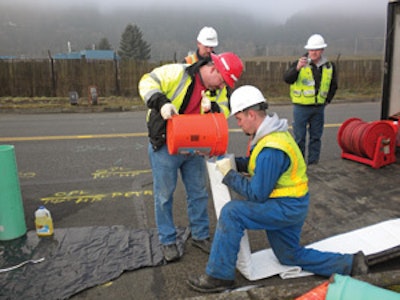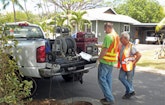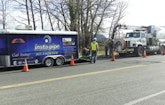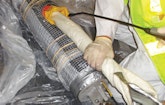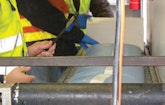Interested in Relining/Rehab?
Get Relining/Rehab articles, news and videos right in your inbox! Sign up now.
Relining/Rehab + Get AlertsBeing a big contractor good at many little things was hard to market, so Dennis Smith, owner of Pipe Experts LLC in Tumwater, Wash., followed the advice of a leading independent tire dealer and divided the company into three separate entities.
Pipe Experts would specialize in locating, inspecting, jetting and pipe bursting for municipalities. Interactive Pipe Inspection (IPI) would concentrate on water and sewer pipeline inspections, and Insta-Pipe Inc. would focus on cured-in-place lateral lining, sectional repairs and main-lateral connections.
The strategy worked, advancing Insta-Pipe and IPI to number one in their market areas. “We are the recognized specialty experts of those industries,” says Smith, 60. “When contractors say they can’t do a project, we jump in and do it.”
Smith intends to expand Insta-Pipe into all 50 states. The heart of his plan establishes stores and allows managers and employees to earn a percentage of the profits. That concept, propelled by the advertising expertise of 37-year-old Nick Patrick, president of Insta-Pipe, has increased sales dramatically.
Duct work
Insta-Pipe subcontracts manhole-to-manhole lining to the big lining companies. “Our goal is to focus on doing just a few things better than anyone else,” says Patrick. “For example, there are only five or six Perma-Liner InnerSeal trailers nationwide, and we have one of them.”
The InnerSeal system launches from the main up the lateral, creating a watertight connection at the junction. The company also has two Perma-Liner lateral lining trailers and a sectional CIPP trailer.
Besides large municipal projects, the company serves commercial, industrial and residential accounts. The jobs are anything but ordinary. One Seattle homeowner called to say that although his furnace was running, it wasn’t heating the basement.
He disconnected the furnace so that Insta-Pipe could inspect the ducts. “They had corroded and were holding water where they ran under the house,” says Patrick. After the firm lined the ducts, the furnace heated the basement.
Another homeowner had water vapor coming out of the kitchen range hood, which vented through a tin duct that passed under heating coils in the floor before leaving the house. An inspection revealed that the metal had corroded, allowing water to collect in the vent. The owner faced tearing up his floor and coils to replace the duct, but instead Insta-Pipe shot the liner from outside the house right up to the range hood, sealing the holes and ending the problem.
Industrial challenges
Industrial projects are often unusual. For instance, when employees on an aircraft assembly line began complaining that the external air-conditioning system was sending a moldy, moist spray into fuselages, Insta-Pipe found that the underground tin ducts had rusted and collected condensate. Lining them solved the problem.
Such success stories evolved from lessons learned before Smith partitioned Pipe Experts. The biggest learning experience involved shooting an 8-inch liner 150 feet up a lateral in an easement. “We were trying to set a national record and stroke our egos,” he says. “The normal distance for 8-inch lateral liners is 100 feet.”
While workers were impregnating the additional 50 feet, the 100 percent ambient-cured solids epoxy cooked off. The team had to pipe-burst the lateral using equipment from TT Technologies. “From then on, we lined laterals longer than 100 feet in two shots,” says Patrick. “As we developed Insta-Pipe, remembering that job helped us remain focused on specialization.”
Municipalities, food processing and manufacturing plants, and government agencies were some of Pipe Experts’ clients. When Patrick joined the company in February 2009, he searched for unusual and challenging opportunities to expand the fledgling Insta-Pipe. But Smith says that the real essence of what he did was adopting the Les Schwab business principles.
Pride of ownership
While waiting for the Les Schwab Tire Center to service a lining trailer, Patrick read a copy of Schwab’s book, Pride in Performance: Keep it Going. He was attracted by how fast Schwab grew his company and his ways of treating customers, employees and vendors. Today, Schwab is a leading independent tire dealer with more than 7,000 employees and 400 stores throughout the West. “His employee fund alone is worth more than $1 billion,” says Patrick. “We wanted to bring his concepts to the lining business.”
Smith hired one of Schwab’s managers to help design the business plan and start the program. The formula was to view each new branch office as a store with its own manager, superintendent, field supervisor, Technician 2 and Technician 1. They all receive a percentage of the profit.
“We wanted our employees to treat Insta-Pipe as if it were theirs,” says Patrick. “To develop pride of ownership, we give them a monetary stake in the company. That changes their entire attitude and the way they handle customers.”
Managers work to own a store. When Insta-Pipe opens a new one, the committee of managers votes on which one becomes the owner. If the person does not accept the opportunity, Smith and Patrick promote a field supervisor to manager.
“Every employee learns how each level works through training,” says Patrick. “I also hand-pick my people from within the industry to minimize employee turnover. My goal is to hire experienced personnel who provide high-quality service.”
By breaking Insta-Pipe into stores, Smith and Patrick avoided the cyclical feast or famine of the service industry. Each location has a store specifically for municipal contracts and another for residential, industrial and commercial accounts. “With two stores working simultaneously, one is always booming,” says Patrick. “Employees from the slow store can help the busier crews stay on schedule and accept more contracts.”
Lateral priorities
Even when Patrick is in the hole installing liners, he’s marketing Insta-Pipe. Contacts from the company’s Web site go to his PDA, while toll-free and office numbers go to his cell phone. He then sends the sales leads to the proper store managers.
“Connections and sectional linings are rapidly expanding the business,” says Patrick. “Municipalities have repaired most of their mains and realize that they can’t solve their I&I problems without taking care of the laterals.”
Besides the Web site and a booth at local trade shows, Patrick’s marketing ploys include visiting old and new clients around noon. He provides brown bag lunches, then gives a brief presentation on the company’s services. Patrick has choreographed all-day demonstrations into major productions.
“When demonstrations involve multiple laterals, I bring all three trailers,” says Patrick. “After an overall presentation on sectional repairs, InnerSeals, and lateral linings, I take municipal staff into the field for live installations.”
Insta-Pipe also rehabilitates manholes. “If it’s a job with manholes and lining, we’ll sometimes take the risk to bid it all or nothing,” says Smith. “We think that ability is unique.” When bids involve main and lateral work, Insta-Pipe subcontracts the mains to any of three or four local contractors.
Any municipal project lasting a month or more is an opportunity to open another store. The most recent addition was Hawaii. “We shipped the InnerSeal trailer with our lining services inside,” says Patrick. “We hand-picked our best employees, flew them over, and hired a manager to run the store.”
As work continued on the municipal project, city residents saw the trailer often enough to recognize the name and began responding to an advertising campaign. “We want to leave equipment and people behind, and that requires a strong start at developing a clientele,” says Smith. “We’ll use this strategy to expand Insta-Pipe city by city and state by state.”
Tidal influence
Branching into Hawaii taught Patrick and crew a few lessons about living on an island with groundwater two feet below grade or less. “When the tide comes in, saltwater pours into the mains from every lateral connection,” says Patrick. “One 3-inch clay lateral had so much I&I that our CUES lateral launch camera saw what looked like the output from a fire hose blasting into the main.”
The crew worked at night to avoid heavy traffic, and around the tides. All the laterals had above-average I&I, but shooting the liners at 14 psi provided sufficient air pressure to push the water back up the pipe. The cold water, however, slowed the cure rate from three hours to five.
What should have been a two-week project lasted a month, mainly due to transportation problems. “Then, after seeing the quality of our work, the municipality added more sectional repairs to the contract,” says Patrick.
Smith continues to emulate Les Schwab’s dominance of the northwest by planning to open stores in Seattle and Tacoma. “As soon as a municipal contract clears a path to those cities, we’re going in,” he says. “It will take time to build a clientele, but our people can do that once they have a foot in the door.”
